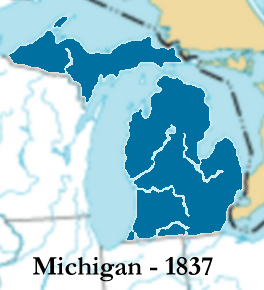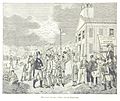Michigan Territory facts for kids
The Michigan Territory was a part of the United States that existed from June 30, 1805, until January 26, 1837. On that date, it officially became the 26th state of the Union, known as Michigan. The main city and capital of the territory was Detroit.
Contents
How Michigan Territory Grew
The Treaty of Detroit was an important agreement signed on November 17, 1807. It was made between William Hull, who represented the United States, and several Native American tribes. These tribes included the Odawa, Ojibwe, Potawatomi, and Wyandot people.
In this treaty, the Native American tribes agreed to give a large area of land to the United States. This land included what is now Southeast Michigan and a part of Ohio near the Maumee River. The tribes were allowed to keep small areas of land within this region. This agreement helped the Michigan Territory grow larger.
How Many People Lived There?
The numbers below do not include most Native Americans. The Northwest Territory, which Michigan Territory was once part of, had 43,365 people in 1800. A territory could apply to become a state once its population reached 60,000 people. This rule was part of the Northwest Ordinance.
| Year | Population |
|---|---|
| 1810 | 4,762 |
| 1820 | 8,896 |
| 1830 | 31,639 |
| 1834 | 87,273 |
| 1840 | 212,267 |
Leaders of the Territory
The governors were important leaders who managed the Michigan Territory. They helped prepare the area to become a state.
| Governor | Dates Served | Notes |
|---|---|---|
| William Hull | March 1, 1805 to October 29, 1813 | |
| Lewis Cass | October 29, 1813 to August 6, 1831 | |
| George Bryan Porter | August 6, 1831 to July 6, 1834 | Died while in office. |
| Stevens T. Mason | July 6, 1834 to September 15, 1835 | Served as Acting Governor because he was the Secretary. |
| John S. Horner | September 15, 1835 to July 3, 1836 | Served as Acting Governor because he was the Secretary. |
Images for kids
-
An 1831 map of Michigan by David H. Burr, showing boundaries of early counties.
See also
 In Spanish: Territorio de Míchigan para niños
In Spanish: Territorio de Míchigan para niños




